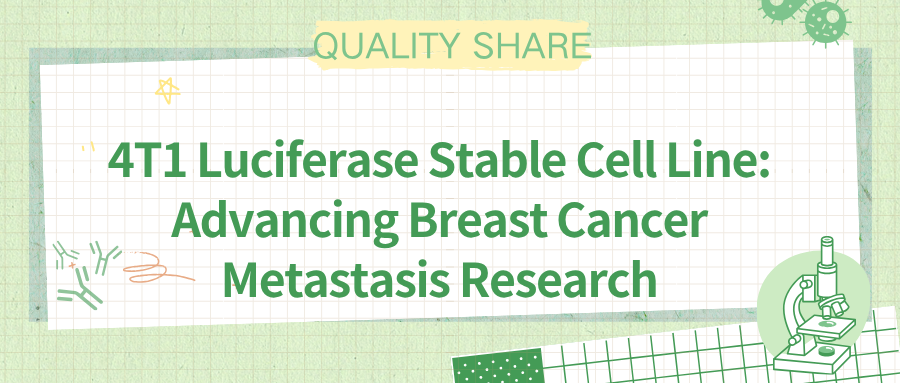[Quality Share] 4T1 Luciferase Stable Cell Line: Advancing Breast Cancer Metastasis Research
-
-

The 4T1 Luciferase (4T1-Luc) stable cell line is a mouse breast cancer cell line engineered to stably express the Firefly Luciferase reporter gene, derived from the highly metastatic parental 4T1 line. Through bioluminescence imaging, the 4T1-Luc cell line enables real-time, non-invasive monitoring of tumor growth and metastasis, making it an ideal model for studies on breast cancer metastasis, drug screening, and immunotherapy.
This instruction provides a detailed overview of how to use the 4T1-Luc cell line to establish breast cancer metastasis models and apply them in scientific research, covering experimental protocols and optimization strategies. By using our ready-to-use 4T1-Luc product, researchers can rapidly initiate experiments and significantly reduce the time required for model construction.01 Advantages of the 4T1-Luc Cell Line in Breast Cancer Research The 4T1-Luc cell line, with its high metastatic potential and stable bioluminescent signal, has become a key tool in breast cancer research and is suitable for the following applications:
- ● Metastasis studies: Models lung, liver, and bone metastasis of triple-negative breast cancer, allowing real-time tracking of metastatic progression.
- ● Drug screening: High-sensitivity bioluminescence enables high-throughput screening of chemotherapeutics, targeted therapies, or nanomedicines.
- ● Immunotherapy research: Used in combination with CAR-T cells or PD-1 inhibitors to evaluate changes in the tumor immune microenvironment.
- ● Gene function validation: Supports gene knockout or overexpression (e.g., CRISPR-mediated E-cadherin editing) to study EMT pathways.
- ● In vivo and ex vivo modeling: Compatible with orthotopic mouse models; non-invasive IVIS imaging reduces the number of animals required.
02 Product Recommendation The 4T1-Luc cell line provided by EDITGENE exhibits >99% purity and high activity, with bulk orders eligible for discounts.
Luciferase Assay Results:
Sample
Rep 1
Rep 2
Rep 3
Mean
Fold Change
WT
1550
2368
4094
2671
42
LUC
107153
113540
112395
111029
● Purity >99%, activity >1.2 × 10⁶ RLU/10⁵ cells (n=3, SD <5%).
Advantages:
● Stable for >20 passages; metastasis efficiency >80% (validated by IVIS).
● COA and SOP are provided; discounts available for bulk orders.
03 Construction of 4T1-Luc Cell Line Pinciple of Construction
The 4T1-Luc cell line is engineered using genetic modification techniques, where the luciferase (luc) gene is inserted into a suitable vector and transfected into the parental 4T1 cells to achieve stable expression. Luciferase catalyzes the oxidation of its substrate, luciferin, generating bioluminescence with a peak wavelength of approximately 550-570 nm. The luminescence intensity correlates linearly with enzyme expression levels. Common configurations include single-luciferase systems or dual-luciferase systems, the latter incorporating Renilla luciferase as an internal control for experimental normalization.
Common Construction Methods
The most widely used approach is lentiviral transduction, as it allows efficient and stable integration. The following outlines a typical workflow using EDITGENE’s 4T1-Luc cell line as an example:
1. Construct the expression vector:
- a. Clone the luciferase (luc) gene into a lentiviral vector (e.g., pLenti or pLVX).
- b. The vector typically includes a promoter (such as CMV) to drive luc expression, a selectable marker (e.g., puromycin resistance) for screening, and a fluorescent tag (e.g., GFP) for visualization.
- c. For dual-luciferase systems, Renilla luciferase can be included as an internal control, either co-expressed or placed on the same plasmid (e.g., pGL3 or pmirGLO).
2.Lentivirus packaging:- a. Co-transfect the recombinant vector with helper plasmids (packaging plasmid psPAX2 and envelope plasmid pMD2.G) into HEK293T cells to produce lentiviral particles.
- b. Collect the viral supernatant, filter, and determine titer (typically 10⁸-10⁹ TU/mL)
a. Select parental 4T1 mouse breast cancer cells and culture until 70-80% confluence.
3. Transduce parental cells:
b. Add viral particles at a multiplicity of infection (MOI) of 10-50 and incubate for 48-72 hours.
c. Transduction efficiency can be evaluated by GFP fluorescence or preliminary luciferase activity assay.
- 4. Select stable clones:
b. Continue selection for 7-14 days until surviving cells form single clones.
c. EDITGENE employs 3D single-cell printing technology to isolate single clones.
-
- (3D single-cell printing precisely separates individual cells, greatly improving the accuracy of monoclonal screening and cell survival. This non-contact method avoids mechanical damage and background contamination, maintaining cell integrity and biological activity. Compared with traditional limiting dilution, 3D single-cell printing reduces human error and ensures reliable screening outcomes.)
- 5. Validation and Applications
- a. Validation Methods: Gene integration can be confirmed by qPCR, protein expression by Western blot, and luciferase activity by bioluminescence assay.
- b. Validation Criteria: Luciferase activity > 10⁶ RLU/10⁵ cells, with stable expression maintained for over 20 passages.
- c. Applications: Cells can be injected into mouse models, and tumor growth can be monitored using an IVIS imaging system after intraperitoneal administration of the luciferase substrate.ction.
04 Application Examples: Advancing Research Projects - 4.1 Breast Cancer Metastasis Mechanism
-
- ● Objective: Investigate the role of the Wnt signaling pathway in lung metastasis.
● Result: Quantification of bioluminescence signals to assess metastasis rates, supporting mechanistic studies.
-
-
- 4.2 Drug Screening
- ● Objective: Screen novel PI3K inhibitors for breast cancer suppression.
-
● Result: Rapid generation of IC50 curves, providing data for publications.
-
- 4.3 Immunotherapy
- ● Objective: Evaluate the efficacy of PD-L1 inhibitors in combination with nanocarriers.
● Result: Dynamic data support translational research.
-
-
05 Summary - The 4T1-Luc stable cell line is a powerful tool for constructing breast cancer metastasis models, playing a critical role in real-time tumor progression monitoring, drug screening, and immunotherapy research. Its high-sensitivity bioluminescence provides reliable data, accelerating research progress. Building this cell line in the laboratory can be time-consuming, whereas EDITGENE’s 4T1-Luc product offers optimized expression (>90% positive rate) and high metastatic efficiency, with COA and SOP included. We invite you to order our 4T1-Luc cells to kick-start your breakthrough research.
06 References -
- ● Tiscornia, G., et al. (2006). Nature Protocols, 1(1), 241–245. DOI: 10.1038/nprot.2006.37.
- ● Pulaski, B. A., & Ostrand-Rosenberg, S. (2001). Mouse 4T1 breast tumor model. Current Protocols in Immunology. DOI: 10.1002/0471142735.im2002s39.
- ● Kim, J. B., et al. (2004). Non-invasive monitoring of tumor growth with bioluminescence imaging. Cancer Research. DOI: 10.1158/0008-5472.CAN-04-1234.
-
-
-
The Luciferase cell line provided by EDITGENE is stably expressing firefly luciferase. This cell line was tested for luciferase activity. Useful for in vitro and in vivo imaging. EDITGENE has a large inventory of Luciferase cells and can provide high-quality products in an efficiently and timely.Luc Overepression Cell Line Construction
-
Follow us on social media
Contact us
+ 833-226-3234 (USA Toll-free)
+1-224-345-1927 (USA)
info@editxor.com












![[Quality Share] 4T1 Luciferase Stable Cell Line: Advancing Breast Cancer Metastasis Research](/uploads/20250328/ESzk5OC49wpxIHVv_3cbfa5e98ea1d238127fe23c72b0f4b2.png)

Comment (4)